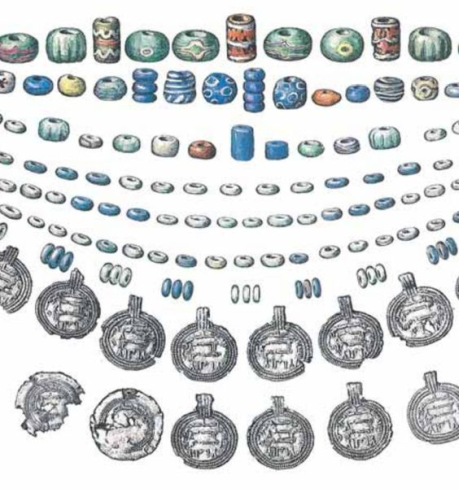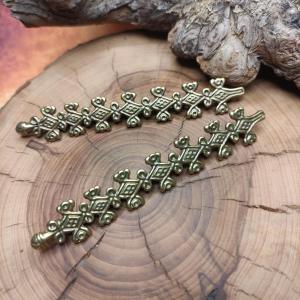Price for 1 piece.
When you buy 10 beads you get 1 free extra (email us which colour or leave it to us).
We know about glassworks in Bohemia as early as the 12th and 13th centuries, when so-called forest glass was produced in forest glassworks. From the 14th century onwards, glassworks in Posumaví distributed huge quantities of beads called pateříky - simple glass beads suitable for making rosaries - named after the first words of the Pater Noster prayer.
In Europe, we have information about such beads made by the Celts 300 BC.
In our territory they are found throughout the whole of ancient and medieval history. In the High Middle Ages and the New Age, Bohemian glass became a sought-after commodity and whole carts full of glass components left our glassworks.
Glass melting and the production of beads was popular in the early Middle Ages and these jewels of various sizes and colours were decorated by Slavs (Great Moravia), in ancient Rome, Vikings and Celts to a degree commensurate with their status and wealth. Such glass was often imported from Italy and not everyone could adorn themselves with whole strings of glass jewellery.
Probably the earliest indications of what we now call a bead, a thing that can be strung on a thread and has a primarily decorative function, date back 38,000 years and were strung animal teeth. In the days when man did not yet know how to use tools, he made do with stringing various porous materials, seeds, claws, teeth, bones, sea coral and sponges, stones, clay, wood, eggshells, amber and shells.
As early as 5000 years ago, the first artisans in what is now India began making polished drilled beads from the soft mineral talc. Beads made from precious stones such as jasper, agate and my favourite, carnelian, were then of great value. (This also features prominently among the beads of the Vikings!)
The first beads that were made from man-made material and reshaped into bead shapes, thus promoting the possibility of mass production and making the product cheaper, was a material called faience. Known only, for example, from Egyptian pottery. This porous material made of siliceous sand, limestone and admixtures of various oxides is considered to be a precursor of glass.
The complexity of working real stone was replaced by the properties, hardness, colour and lustre of glass beads. Their origins date back to the Caucasus and India from 2400 to 1700 BC. They quickly became a much sought-after commodity and a major export item for which everything, including gold, could be exchanged. However, the drawn ones, known as coiled ones, do not appear until 300-200 BC.
So how is such glass made? Let's briefly brush up on your school knowledge. The silica contained in silica sand melts at a temperature of around 2000 degrees Celsius. The higher the melting point of the glass, the more expensive the product is, as much more fuel is needed to produce it. However, this can be circumvented by the addition of potash and soda and the glass can be melted as low as around 1000 °C. Then, by combining different oxides, iridescent colours are produced. But each smelter guards the secrets of its shades like an eye in the head.
We are still amazed at how many experiments and crazy ideas and the need to create must have prevented people thousands of years ago from creating such glass.
Our beads are made from Czech glass made from what are known as lamp sticks - they are melted over the fire of a gas lamp.
Each piece is an original handmade by me, the diameter of the bead is about 1 cm, weight about 1 g. For the stringing material it is also important to note that the diameter of the stringing hole is 3mm.
Our tip: glass beads are a typical element for a girl's costume. Whether it's a lunette, Thor's hammer or another amulet, they add a more historical touch to your pendant.

By the way - by arrangement I can make different coloured beads and replica beads, or organize small classes for the public, for children and adults.






















